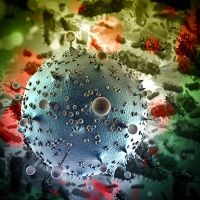New Approach Disrupts HIV and Hepatitis C Infection Processes
A new strategy may be able to effectively prevent transmission of the human immunodeficiency virus (HIV), other sexually transmitted viruses, and additional illnesses.

A new strategy may be able to effectively prevent transmission of the human immunodeficiency virus (HIV), other sexually transmitted viruses, and additional illnesses.
The most common route of HIV transmission is through semen, which contains protein fragments called amyloid fibrils. The fibrils can help HIV attach to the membrane of human cells and enhance the virus’ infectivity by 10,000 times. Researchers from the Perelman School of Medicine at the University of Pennsylvania found a way to interfere with this initial phase of infection using a tweezer-shaped molecule, CLR01.
According to research published in eLife, CLR01 binds to the amyloid fibrils in order to prevent the virus interactions that lead to transmission. Not only did the molecule’s antiviral activity destroy HIV particles, but it also inhibited the fibrils’ transmission-promoting activity. CLR01 attacked the viral membrane without harming others.
“Remarkably, CLR01 does not affect cell membranes, which suggests it could be safely incorporated into a vaginal or anal gel to prevent HIV infection — without the risk of side effects,” senior author James Shorter, PhD, an associate professor of Biochemistry and Biophysics at the university, said in a news release.
In addition, CLR01 was able to interfere with the infection process in hepatitis C; and based on the understanding of how the molecule works, the researchers believe that it may be effective against other sexually transmitted viruses as well as the flu and Ebola. These findings could lead to preventive treatments to reduce the rates of transmission.
“Each strategy diminished the ability of amyloid to promote HIV infection, so this approach has potential as a therapeutic,” Shorter continued.
The next phase of this research would be to look at the safety and efficacy of the strategy in non-human primates. The researchers suggest focusing on protective agents that target HIV host factors.
“We think that CLR01 could be more effective than other microbicides that are in development because of its dual action, its safety in terms of side effects and its potential broad application,” Shorter concluded.